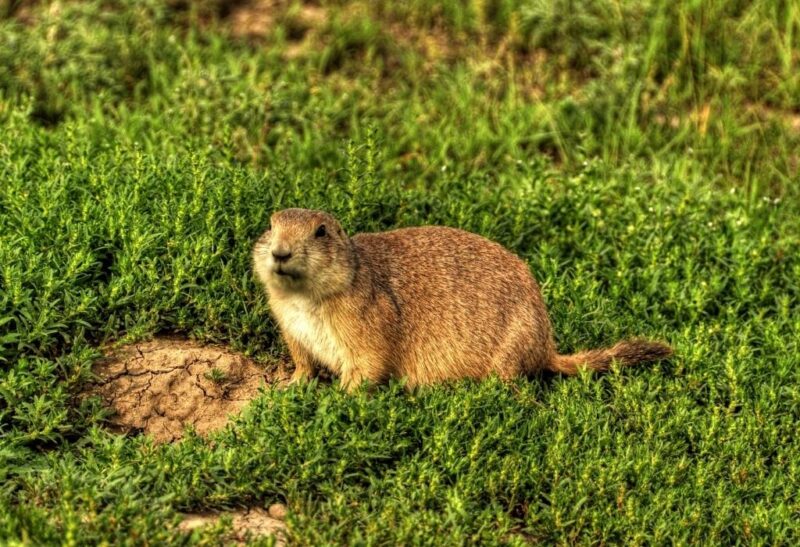When you think of animals that live underground, you often think of moles and gophers. But these are not the only animals who prefer to dig holes and live underground – you might even be surprised by some of them. In this article, you’ll be introduced to most of them.
What are the animals that live underground? The 22 animals that live underground are the following:
- Desert Tortoise
- Polar Bear
- American Badger
- Jerboa
- Pocket Gopher
- Kingfisher
- Red Fox
- Wombat
- Weasel
- Nine-Banded Armadillo
- Funnel Web Spider
- Chinese Pangolin
- Dwarf Mongoose
- Fennec Wolf
- American Pika
- Burrowing Owl
- Mole
- Chipmunk
- Groundhog
- Prairie Dog
- Mouse Spider
- Bilby
From the list above, you can see that animals that live underground range from small mammals to birds and rodents. What’s interesting is the reason why they choose to live underground and how they manage to survive. That’s exactly what this article will teach you.
Table of Contents
How Do Animals Survive Underground?
Animals who live underground, also known as fossorial animals, survive by burrowing in tunnels to create a safe space for themselves. These animals have successfully adapted to living underground in that they have developed strong claws for digging and are capable of navigating dark tunnels with ease.
In most cases, living underground has helped a variety of animals in surviving against attacks from predators. They create these burrows to serve as their nests, where they can safely give birth and raise their young. At the same time, it becomes their safe place when it’s time to rest after a long day of hunting.
In other instances, these burrows protect them from harsh climates. Whether it’s from extreme heat or extreme cold, underground tunnels help maintain ideal living temperatures for these animals. That’s how they can survive living underground.
How Do Underground Animals Get Water?
Underground animals get water by creating a sump inside their burrows. As earlier established, underground animals have fully adapted to living underground. As such, they make sure their underground homes are livable – and that includes making sure that there’s enough water to come around.
The underground sump helps collect water that passes through the burrows and tunnels they have created. What’s interesting is that these animals know how to control the amount of water that passes through their burrows. When it’s raining hard, these animals plug the entrance to their burrows to keep water from overflowing and destroying their homes.
22 Animals That Live Underground
Desert Tortoise
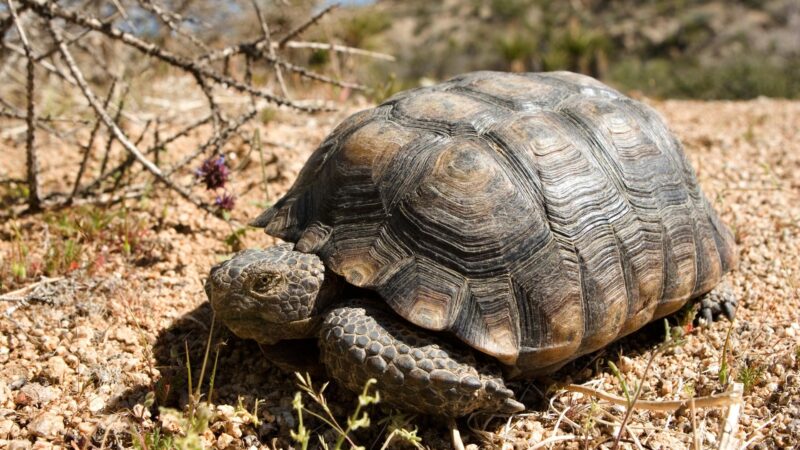
The desert tortoise is one of the animals that live underground. At first glance, these large reptiles look like they don’t do much. Surprisingly, they are excellent diggers, who are capable of digging burrows between three to ten feet deep.
These burrows often provide them shelter against extreme summer heat and the freezing winter cold. Additionally, by staying in these burrows, their bodies can maintain the ideal body heat while reducing water loss at the same time. Interestingly, the desert tortoise can survive long periods even with little food – and that helps them survive living underground.
- Scientific Name: Gopherus agassizii
- Appearance: The desert tortoise is a large tortoise species with a high domed shell. It has a set of thick legs with visible scales on the front. The desert tortoise’s forearms are noticeably muscular and have thick nails that help them burrow through the soil.
- Color: Brown or gray
- Lifespan: Up to 80 years
- Habitat: Desert, grassland, tropical forest
- Height: 14 inches
- Weight: 8 to 15 pounds
- Diet: Grasses, flowers, fruit, and cactus
- Place Of Origin: Southwestern United States and Northwestern Mexico
- Characteristics: Diurnal, quadruped, non-venomous, aggressive, docile, and intelligent
Polar Bear
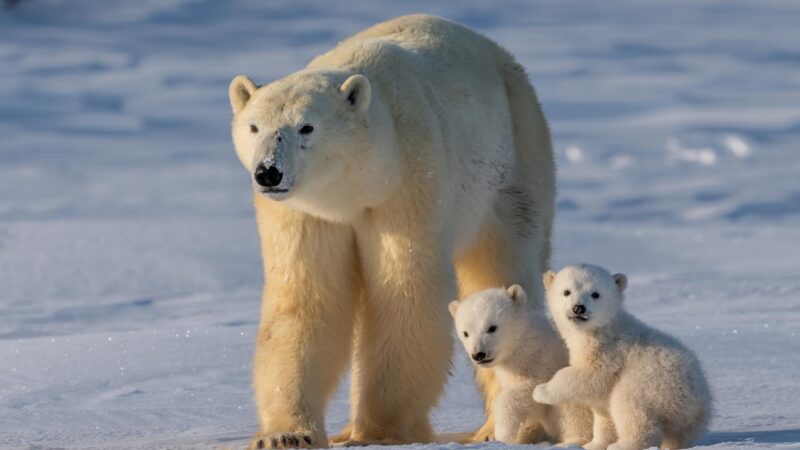
The polar bear is another animal that lives underground. This may come as a surprise since polar bears are often seen hunting and playing above the ground. Neither do they hibernate during the winter since they thrive in low temperatures.
However, it is the mother polar bear who is responsible for the burrowing. Polar bears have excellent maternal instincts, and they create underground dens where they can give birth to their cubs. These cubs stay in these subterranean nests until they are about three months old.
- Scientific Name: Ursus maritimus
- Appearance: Polar bears are large bear species covered in shaggy white fur. They have bulky bodies with round faces and long snouts. The polar bear has a notably long and thick neck, something that is not common among other bear species. Polar bears also have thick, powerful claws that help them hunt, swim, and create burrows for their young.
- Color: White
- Lifespan: 25 to 30 years
- Habitat: The Arctic
- Height: 5 to 9 feet
- Weight: 770 to 1,540 pounds
- Diet: Fish and seals
- Place Of Origin: Ireland
- Characteristics: Crepuscular, quadruped, aggressive, docile, friendly, and intelligent
American Badger
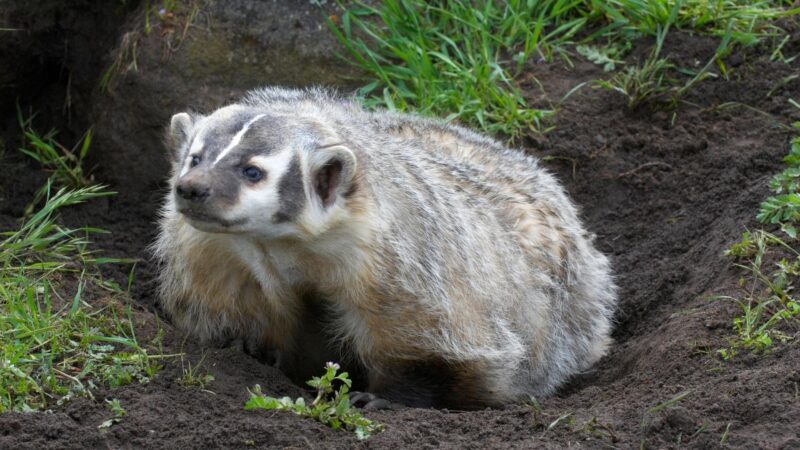
The American badger is one of the known animals that have successfully adapted to living underground. They are known for creating tunnels up to 98 feet deep with multiple entrances. This allows them to travel to different places without being seen on land. This small mammal also mainly feasts on food already found underground, such as earthworms and burrowing rodents.
Despite its unassuming appearance, the American badger has a reputation for being aggressive. And the fact that they have such powerful claws makes them hard to prey upon.
- Scientific Name: Taxidea taxus
- Appearance: The American badger has a seemingly flat body covered in shaggy black and white fur. It has four short and stout legs with long and powerful claws. The American badger has a triangular head with a pointed nose. While its face is predominantly black, it has white stripes at the center of the face and along each eye.
- Color: Brown or black
- Lifespan: 25 years (captivity), 14 years (in the wild)
- Habitat: Plains, prairies, and farmland
- Height: 9 inches
- Weight: 14 to 16 pounds
- Diet: Earthworms, frogs, rodents, birds, eggs, lizards, insects, bulbs, seeds, and berries
- Place Of Origin: Canada, Central U.S., and Northern Mexico
- Characteristics: Nocturnal, quadruped, non-venomous, aggressive, docile, and intelligent
Jerboa
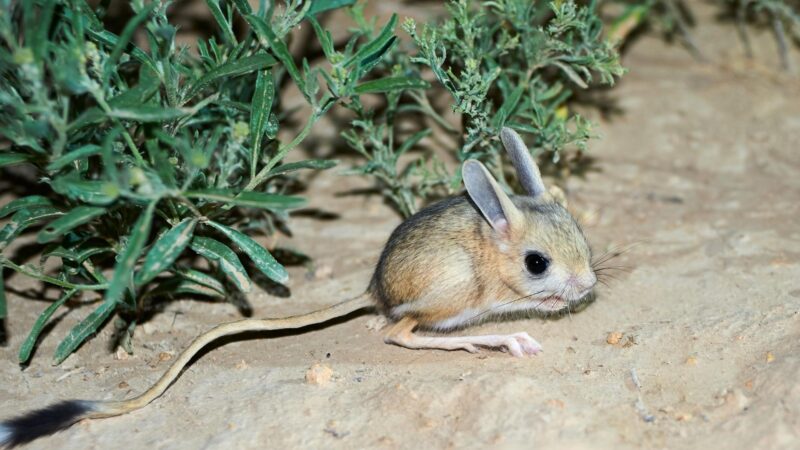
The jerboa is an adorable animal that survives its desert habitat by burrowing underground. They are best known for looking like a cross between rabbits and mice, thanks to their long ears and small mouse-like bodies.
The first characteristic you will notice about a jerboa is its pair of long legs. These legs are quite powerful, allowing them to hop at speeds of up to 16 miles per hour. With that said, jerboas can create deep burrows with the help of these powerful legs – sometimes even reaching a depth of ten feet. These burrows help them through hot desert summers and freezing winters.
- Scientific Name: Allactaga
- Appearance: The jerboa has a mouse-like face and body with long rabbit-like ears. It has large beady eyes sitting on top of its face. The jerboa has a pair of small arms, as well as a pair of long muscular legs. It has a long slender tail with black and white fur at the tip.
- Color: Light brown
- Lifespan: 6 years
- Habitat: Desert areas
- Height: 2 to 6 inches
- Weight: 0.88 to 1.06 ounces
- Diet: Desert plants
- Place Of Origin: North Africa and Asia
- Characteristics: Nocturnal, biped, non-venomous, friendly, and intelligent
Pocket Gopher
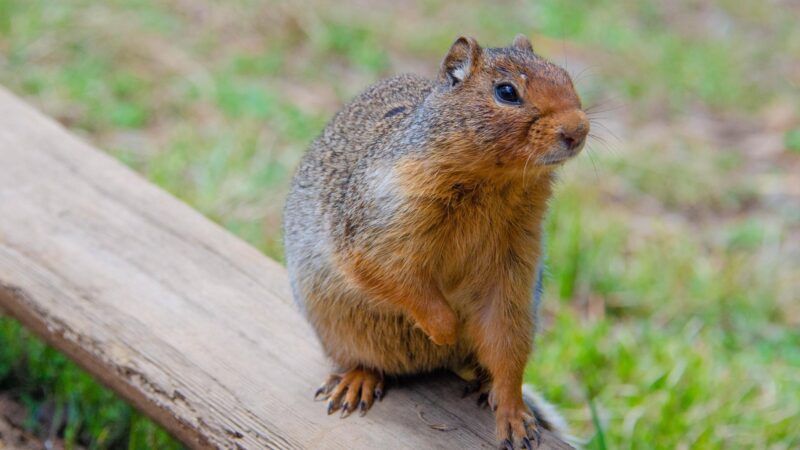
The pocket gopher, more commonly known simply as the gopher, is another animal that lives underground. This burrowing rodent is known for its strong arms and long claws that allow it to dig extensive tunnels.
The pocket gopher is so named because of its large cheeks that look like pouches. However, don’t let its adorable exterior fool you – this rodent is quite aggressive and is known to attack humans and animals when it feels threatened.
- Scientific Name: Geomyidae
- Appearance: The pocket gopher is a small rodent with stocky bodies supported by short, muscular legs. It has a long face with chubby cheeks, a pair of small beady eyes, and small curved ears on the sides of its face. It has noticeably long claws, which it uses to burrow underground. Its body is covered in short brown fur.
- Color: Black to pale brown
- Lifespan: 3 years
- Habitat: Sandy soil with edible plant cover
- Height: 7 to 14 inches
- Weight: 5 to 9 ounces
- Diet: Plants, shrubs, and trees
- Place Of Origin: Manitoba to Texas
- Characteristics: Nocturnal, quadruped, docile, friendly, and intelligent
Kingfisher

It may come as a surprise that the brightly-colored kingfisher burrows on the ground. Specifically, this bird prefers to dig burrows near bodies of water which they use as a nest for their young. As their name implies, kingfishers are excellent catchers of fish. That’s why they prefer living near a body of water.
- Scientific Name: Alcedinidae
- Appearance: Kingfishers have bright blue feathers covering the upper half of their bodies, while the lower half is covered in bright orange feathers. They also have white feathers under the bill and on the sides of the neck that look like a white bib. This bird species is known for its long and hard bill, which it uses to catch its prey.
- Color: Orange, cyan, and blue
- Lifespan: 6 to 10 years
- Habitat: Aquatic regions like rivers, lakes, and streams
- Height: 4 to 16 inches
- Weight: 1 ounce
- Diet: Fish, frogs, snails, worms, lizards, snakes, grasshoppers, spiders, shrimp, crabs, mice
- Place Of Origin: Lower Eocene rocks in Wyoming and Middle Eocene rocks in Germany
- Characteristics: diurnal, biped, non-venomous, aggressive, friendly, and intelligent
Red Fox
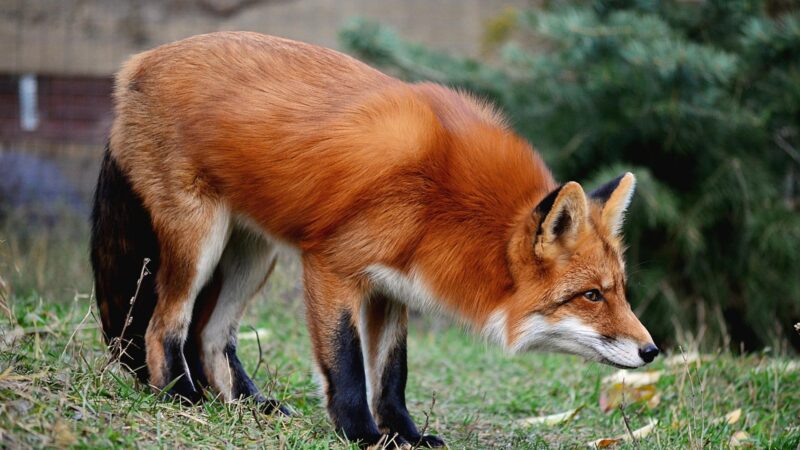
The red fox is another animal that is known to live underground. This four-legged mammal is an excellent digger and prefers to live in hollowed-out burrows on the ground – otherwise known as a fox den. Aside from being a safe place where they can rest, foxes use their dens to store food and serve as a nursing ground for their new pups.
- Scientific Name: Vulpes vulpes
- Appearance: The red fox is a four-legged mammal with a slender body covered in reddish-brown or copper fur. It has a rounded face with a pointed snout, as well as a pair of pointed ears perched on top of its head. Red foxes usually have dark-colored fluffy tails, as well as four legs covered in dark gray or black fur. They also have white fur on their belly area.
- Color: Red and white
- Lifespan: 3 to 4 years
- Habitat: Forests, deserts, grassland, marshes
- Height: 14 to 20 inches
- Weight: 10 to 15 pounds
- Diet: Rodents, rabbits, birds, amphibians, and fruits
- Place Of Origin: North America
- Characteristics: Crepuscular, quadruped, non-venomous, docile, friendly, intelligent
Wombat
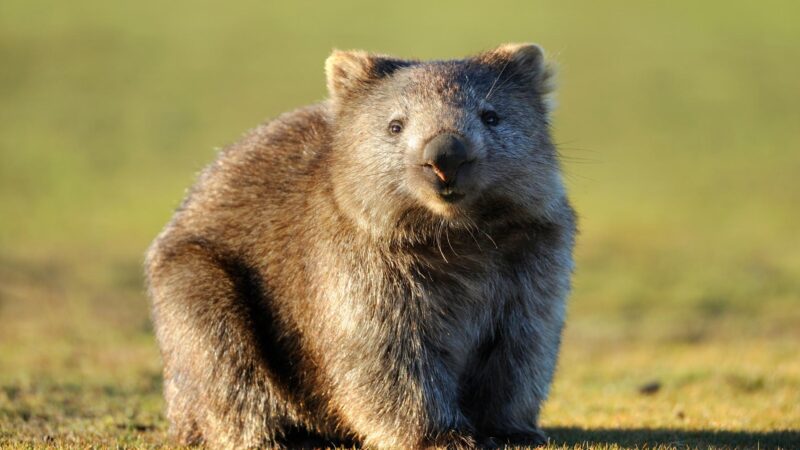
Another animal that’s known to live underground is the wombat. These adorable animals are known for burrowing extensive tunnels that can reach up to 98 feet long and a few feet deep. They use these tunnels to hide from their predators and to stay cool during the hot summer season.
- Scientific Name: Vombatidae
- Appearance: Wombats look like miniature bears. They have stocky bodies supported by short, muscular legs. They have a round face with a snout and a pair of pointed ears on top of their heads. Their fur is short and is often brown-colored, but it can also be gray or a combination of black and gray.
- Color: Brown, black and gray
- Lifespan: 15 years
- Habitat: Wet forested areas near the coast as well as on the ranges and western slopes
- Height: 24 to 28 inches
- Weight: 44 to 77 pounds
- Diet: Grasses, sedges as well as roots of shrubs and trees
- Place Of Origin: Australia
- Characteristics: Nocturnal, quadruped, non-venomous, aggressive, and intelligent
Weasel
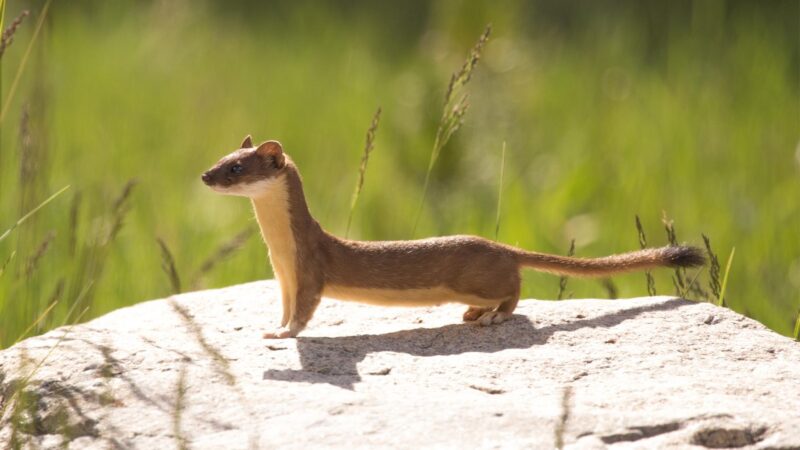
The weasel is another small mammal that lives underground. They are quite agile, which allows them to create 10-feet long tunnels to use as their nest, prey trap, and storage space for excess food.
While weasels are perfectly capable of digging their weasel holes, some of them take advantage of burrows made by other animals. Often, these burrows are already abandoned by the previous animal owner.
- Scientific Name: Mustela
- Appearance: Weasels are adorable animals with long slender bodies supported by short legs. They have long necks and round-shaped heads. They have a pointed nose, beady eyes, and a pair of small curved ears resting on top of their heads. The fur on the upper half of its body is either brown or reddish-brown, while the fur from below its mouth extending to the underbelly is white or creamy-white.
- Color: Brown and white, reddish-brown and white
- Lifespan: 10 years
- Habitat: Urban lands, lowland pasture, woodland, marshes, and moorlands
- Height: 7 to 14 inches
- Weight: 3 to 12 ounces
- Diet: Mice, voles, rabbits, gophers, and chipmunks
- Place Of Origin: Europe, North and South America
- Characteristics: Diurnal, quadruped, active, aggressive, and intelligent
Nine-Banded Armadillo
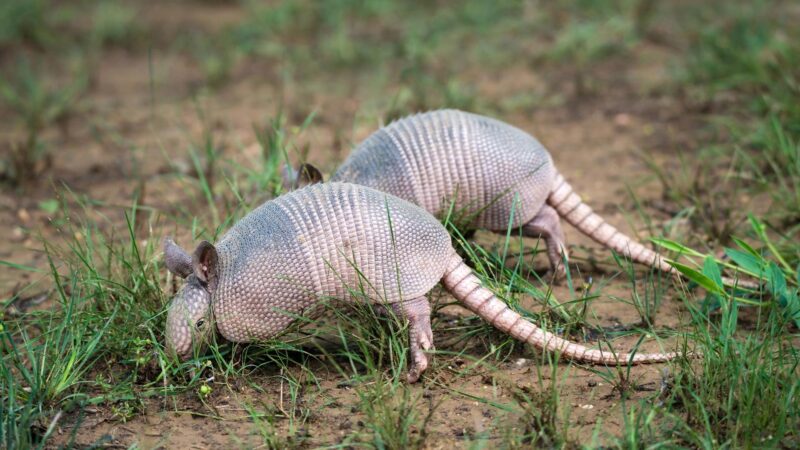
The nine-banded armadillo is an excellent digger, which is why it’s one of the known animals that live underground. In fact, armadillos are known to dig several burrows within one territory, and each may serve a different purpose. For example, one may be used as a nursery for their young, while others are used as their shelter.
Interestingly, the nine-banded armadillo primarily eats small insects that often hide underground, such as ants and termites. Now, it’s easy to see why they became such excellent diggers.
- Scientific Name: Dasypus novemcinctus
- Appearance: The nine-banded armadillo is a small quadruped mammal with an elongated head, a long snout, and a pair of pointed ears on top of its head. Its most notable feature is its hard jointed armor with nine bands along its midsection – hence, the name. Despite its thick armor, its underbelly is quite soft. The nine-banded armadillo also has four short legs, with the forefeet having strong powerful claws.
- Color: Pink, red, black, gray, or yellow
- Lifespan: 12 to 15 years
- Habitat: Forests, scrub, and brushlands
- Height: 5 to 9 inches
- Weight: 5 to 14 pounds
- Diet: Small insects like ants and termites
- Place Of Origin: South America
- Characteristics: Nocturnal, quadruped, non-venomous and friendly
Funnel Web Spider
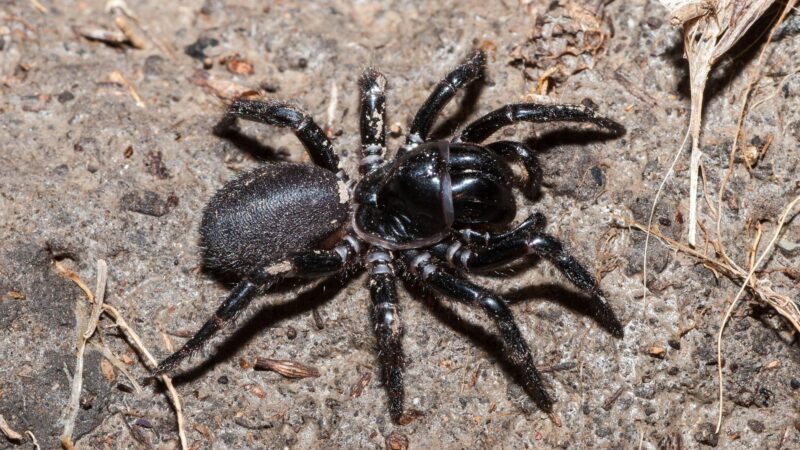
The funnel web spider is among the spider species known to live underground. This spider burrows underground, so it can have a cool yet humid place to live in. Interestingly, the Funnel Web Spider sets traps just outside of its burrow to trip and catch its prey.
- Scientific Name: Atracidae
- Appearance: The funnel web spider has features similar to a hairless tarantula. It has a thick body supported by eight thick and long legs. The funnel web spider has a shiny exterior that’s either black or dark brown.
- Color: Black to brown
- Lifespan: 20 years
- Habitat: Moist forest regions
- Height: 0.4 to 2 inches
- Weight: 6 ounces
- Diet: Mostly insects but can also eat frogs and lizards
- Place Of Origin: Australia
- Characteristics: Nocturnal, venomous, and aggressive
Chinese Pangolin
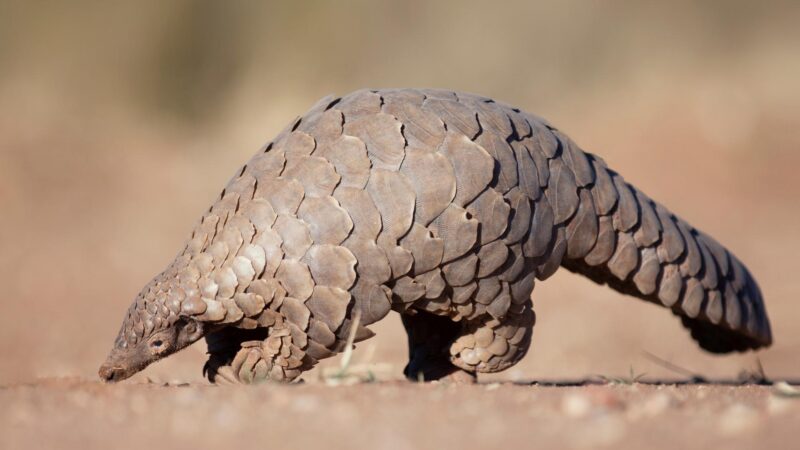
The Chinese pangolin is one of the known animals that stay long hours underground. This four-legged mammal is skilled at digging deep burrows with circular chambers, which they use for their day-to-day living. These burrows serve as their home, where they spend most of their days in. Being nocturnal animals, the only time they leave the burrows is at night, when it’s time to search for food.
- Scientific Name: Manis pentadactyla
- Appearance: The Chinese pangolin is notable for its hard armor-like scales that start from the top of its head to the tip of its tail. It has a bulky body with muscular arms and legs. Its arms have three long and sharp claws, which come in handy when it comes to digging burrows. The Chinese pangolin has a small face with a long snout.
- Color: Yellowish, olive, and dark brown
- Lifespan: 15 years
- Habitat: Tropical forests, grasslands, and agricultural fields
- Height: 16 to 23 inches
- Weight: 8 pounds
- Diet: Insects
- Place Of Origin: Northern Indian subcontinent, Northern parts of Southeast Asia, and Southern China
- Characteristics: Nocturnal, quadruped, non-venomous, docile, friendly, and intelligent
Dwarf Mongoose
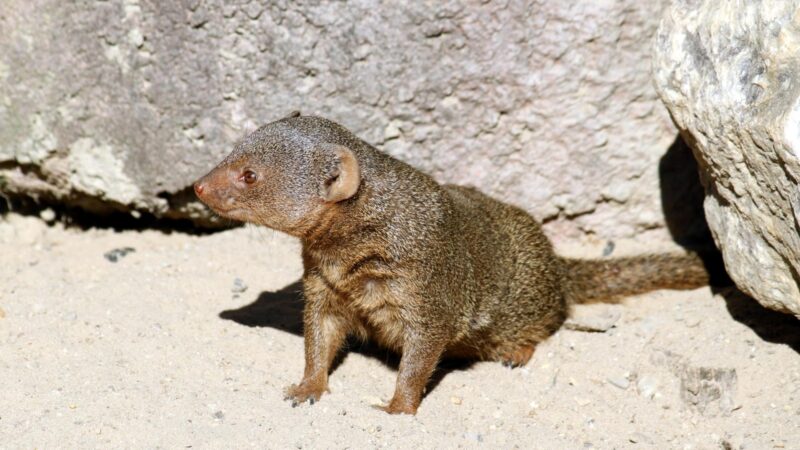
The dwarf mongoose is another animal who lives underground – often using it as a safe hideout when a predator is nearby. However, they do not dig up the burrows themselves. Instead, they take advantage of abandoned burrows dug up by other animals.
What’s interesting is that dwarf mongooses live in large packs that help each other survive the wild. These animals take turns to watch over their territory, who will then be responsible for alerting the others, in case they sense danger nearby.
- Scientific Name: Helogale parvula
- Appearance: The dwarf mongoose is a small mammal with a long body and tail. It has a small face, a pointed nose, and a pair of curved ears. Its body is covered in short bristle-like fur.
- Color: Brown or reddish
- Lifespan: 18 years
- Habitat: Savannah, woodlands, brush country, and mountain scrub
- Height: 7 to 10 inches
- Weight: 10 ounces
- Diet: Insects and fruits
- Place Of Origin: Angola, Northern Namibia, South Africa, and Zambia
- Characteristics: Diurnal, quadruped, non-venomous, aggressive, friendly, and intelligent
Fennec Wolf (Fennec Fox)
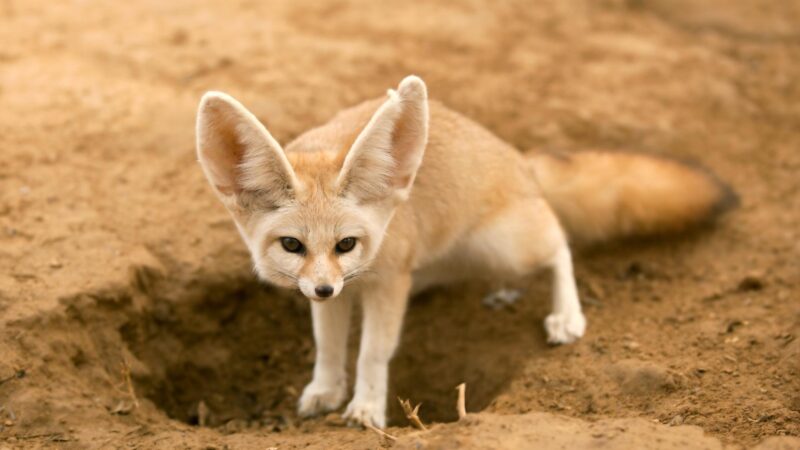
The fennec wolf, otherwise known as the fennec fox, lives in underground burrows called dens. Compared to other animals on this list, the fennec fox den can be considered shallow, often only reaching around three feet deep.
The fennec fox lives in the desert, and their dens serve as a means to escape the scorching desert heat. Thus, fennec fox dens are often dug in areas where moisture can be retained, such as the base of hills.
- Scientific Name: Vulpes zerda
- Appearance: The fennec fox is the smallest mammal in the fox family and is characterized by its long ears. It has a small head, a pair of upturned eyes, and a pointed nose. It has a small slender body covered in cream-colored fur. It has a long and fluffy tail, also covered in cream-colored fur.
- Color: Cream, light brown
- Lifespan: 10 years
- Habitat: Sandy Desert
- Height: 8 inches
- Weight: 4 pounds
- Diet: Mostly insects, but they can also eat small rodents, lizards, and birds.
- Place Of Origin: Africa and Arabia
- Characteristics: Nocturnal, quadruped, non-venomous, aggressive, and intelligent
American Pika
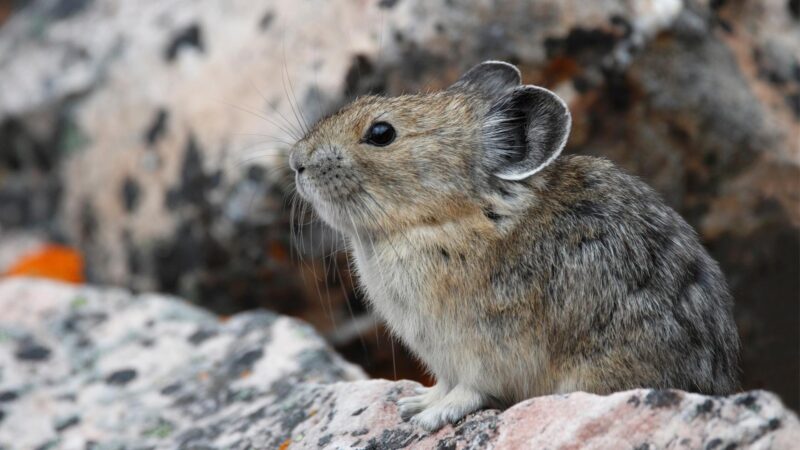
The American pika is a small mouse-like mammal that lives underground – particularly in rocky and mountainous areas. However, these small herbivores do not dig up the burrows themselves. Instead, they look for abandoned dens or live in spaces under rocks.
- Scientific Name: Ochotona princeps
- Appearance: The American pika is a small mammal with short round bodies, beady eyes, and a pointed nose. They have thin and short legs. Their body is covered in short brown fur.
- Color: Grayish to cinnamon-brown
- Lifespan: 7 years old
- Habitat: Cliffs near mountain meadows
- Height: 4.25 to 4.75 inches
- Weight: 4 ounces
- Diet: Grasses, weeds, and tall wildflowers
- Place Of Origin: North America
- Characteristics: Diurnal, quadruped, non-venomous and aggressive
Burrowing Owl
You may think that owls usually nest on trees, but the burrowing owl is an exception. As its name implies, this owl breed prefers to dwell underground. But ironically, they do not dig their burrows. They instead take over those that were previously abandoned by burrowing mammals.
- Scientific Name: Athene cunicularia
- Appearance: The burrowing owl has a long and slender body as opposed to other owls. It has a dome-shaped head with yellow eyes, a long narrow beak, and what appears like white eyebrows on top of its eyes. It has a plumage of brown and white feathers, except for its lower body which is covered in white feathers only. Its most notable feature is its pair of long legs.
- Color: Sandy brown
- Lifespan: 9 years
- Habitat: Open, dry, sparsely vegetated land
- Height: 9 inches
- Weight: 5 ounces
- Diet: Large insects
- Place Of Origin: Western Canada to Southern Mexico and Western Central America
- Characteristics: Diurnal, biped, non-venomous and docile
Mole

Without a doubt, moles are one of the most popular underground-dwelling animals. They have successfully adapted to the subterranean lifestyle, and their limbs are strong enough to dig through the soil with ease. In fact, it has been observed that moles can burrow at a speed of up to 15 feet per hour – and that’s quite impressive considering their size.
- Scientific Name: Talpidae
- Appearance: Moles have bulky bodies supported by four muscular legs. Particularly, it has a pair of strong forelegs with large claws. They have a long pointed face, with a snout and a pair of small eyes. Their bodies are covered in black velvet-like fur.
- Color: Black, cream, gray, orange, white
- Lifespan: 6 years
- Habitat: Grasslands, dunes, woodlands, swamps, and wetlands
- Height: 4 to 7 inches
- Weight: 0.42 ounces
- Diet: Insects, grubs, and earthworms
- Place Of Origin: Mexico
- Characteristics: Crepuscular, quadruped, non-venomous, aggressive, and intelligent
Chipmunk
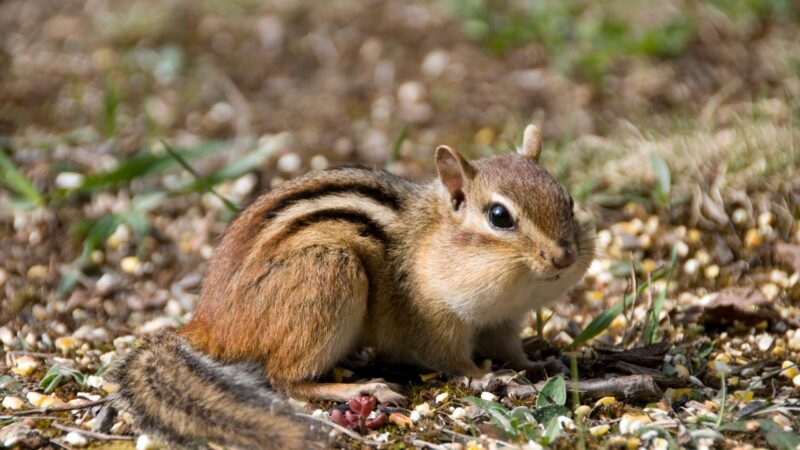
It may seem like chipmunks live inside hollow trees, but they live in an extensive system of burrows.
It has been observed that chipmunks dig various burrows of different depths. They have shallow burrows that serve as a quick hideout whenever they need to run while out looking for food. On the other hand, the deeper burrows are used either as a nursery, a place for resting, or as food storage spaces.
- Scientific Name: Tamias
- Appearance: Chipmunks are small rodents with mouse-like features. They have small bodies supported by short, muscular limbs. Their bodies are predominantly covered in short brown fur, but it has noticeable black and white stripes along the sides of its body. They have rounded faces, small noses, a pair of beady eyes, and curved ears on its head. Chipmunks are also known for their large cheeks.
- Color: Gray to reddish-brown and white bellies
- Lifespan: 2 to 5 years
- Habitat: Forests and thick bushes
- Height: 3 to 4 inches
- Weight: 2 to 5 oz
- Diet: Seeds, berries, and nuts
- Place Of Origin: North America
- Characteristics: Diurnal, non-aggressive, and intelligent
Groundhog
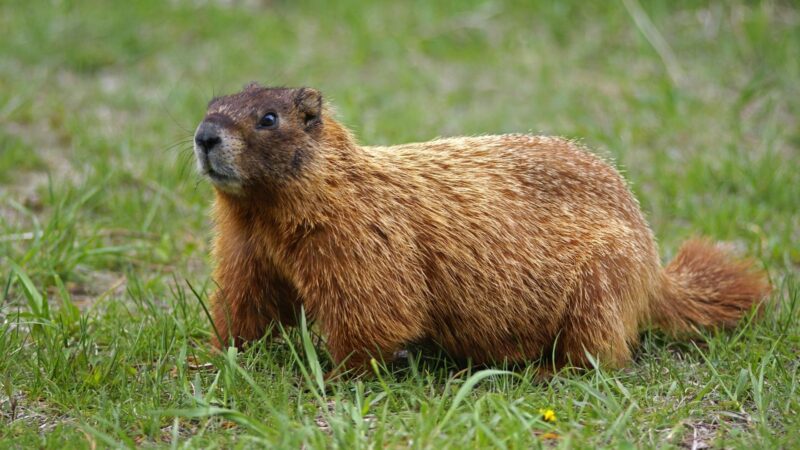
As the name implies, groundhogs are animals that also live underground. Considered the largest member of the squirrel family, groundhogs are excellent diggers who burrow in elevated areas to keep them safe in case it floods.
But aside from burrowing, groundhogs are also capable of swimming and climbing trees. That comes to their advantage whenever they are searching for food.
- Scientific Name: Marmota monax
- Appearance: Groundhogs look like large squirrels with bulky bodies and short muscular arms. They have small eyes, a pointed nose, and a pair of small curved ears at the top of the head. They have long bushy tails, as well as bodies covered in short brown hair.
- Color: Brown to gray
- Lifespan: 6 years
- Habitat: Forest edges, meadows, open fields, roads, and streams
- Height: 20 inches
- Weight: 13 pounds
- Diet: Plants
- Place Of Origin: Eastern United States, across Canada, and into Alaska
- Characteristics: Diurnal, quadruped, non-venomous, docile, friendly, and intelligent
Prairie Dog
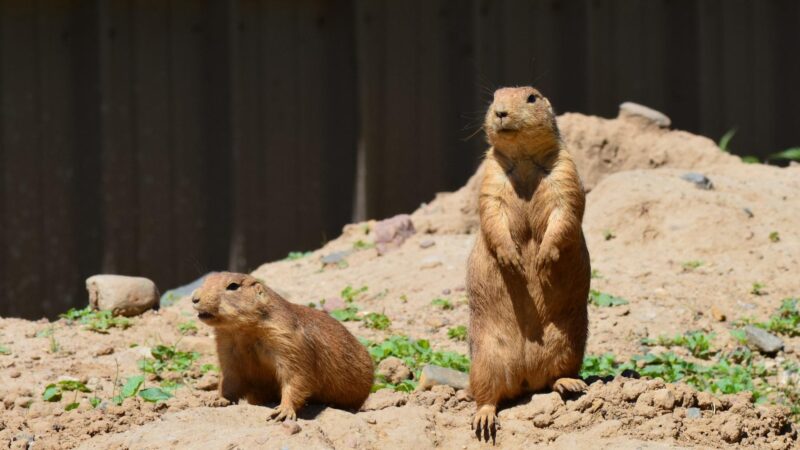
Another rodent that lives underground is the prairie dog. Despite their small size, prairie dogs are exceptional diggers, often creating intricate tunnels up to 15 feet in length.
At first glance, a prairie dog mound seems like an unassuming hole in the ground. But, the elevated top helps prevent water from entering the tunnels while also serving as a lookout point.
- Scientific Name: Cynomys
- Appearance: Prairie dogs are four-legged rodents with bulky bodies and short slender limbs. They have a small elongated face with a small nose, beady eyes, and small ears on the top side of their heads. Their bodies are covered in short light brown or yellowish-brown fur.
- Color: Light brown or yellowish brown
- Lifespan: 3 to 4 years
- Habitat: Dry, flat, sparsely vegetated grasslands
- Height: 16 inches
- Weight: 3 pounds
- Diet: Seeds, stems, roots, grasses, weeds, and leaves
- Place Of Origin: North America
- Characteristics: Diurnal, quadruped, venomous, aggressive, and intelligent
Mouse Spider
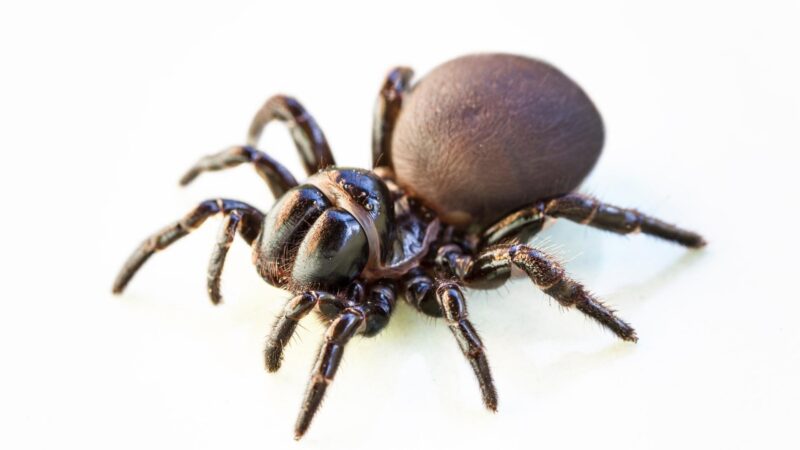
The mouse spider is among the most aggressive animals that live underground. Despite its miniature size, it has been known to attack larger animals such as frogs and geckos.
Interestingly, the mouse spider burrows underground, which serves both as a nest and a trap. Also, it’s quite easy to tell a mouse spider hole because of its clean oval shape on the ground.
- Scientific Name: Missulena
- Appearance: The mouse spider is a small spider breed with a bulky body and 8 short yet thick legs. It has quite a menacing appearance, owing to its bright red head and visible fangs. Aside from the head, the rest of its body is blue-black, black, or dark brown.
- Color: Blue-black, black, or dark brown
- Lifespan: 4 years
- Habitat: Rivers, creeks, and other waterways
- Height: 1.3 inches
- Weight: 0.3 pounds
- Diet: Insects and small creatures
- Place Of Origin: Australia
- Characteristics: Crepuscular, venomous, and aggressive
Bilby
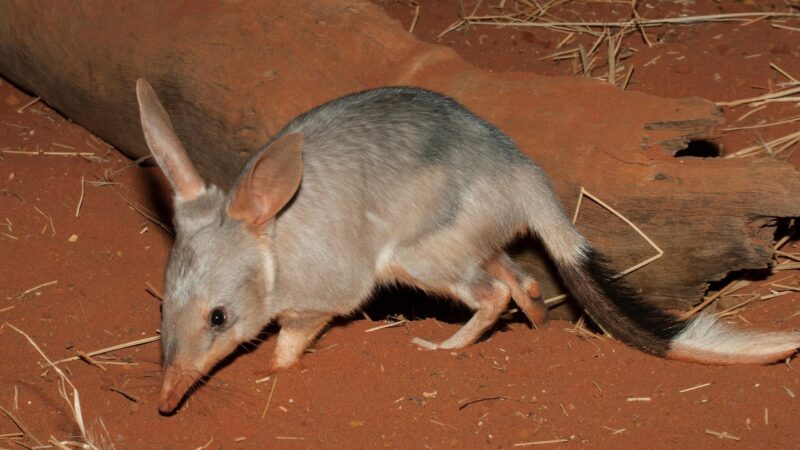
The bilby is known for its strong forelimbs and powerful claws that allow it to dig multiple burrows around its desert habitat. They use these burrows to escape the desert heat and would only leave them at night to search for food.
- Scientific Name: Macrotis
- Appearance: Bilbies are often noted to look like small kangaroos with some mouse-like features. They have long pointed ears, round bodies, muscular limbs, and a long mouse-like tail. They also have a long mouse-like face with a small pointed nose. Their bodies are covered in short blue-gray or light brown fur.
- Color: Blue-gray, light brown, brown
- Lifespan: 7 years
- Habitat: Grasslands, stony downs country, and desert sandplains and dunefields
- Height: Up to 22 inches
- Weight: 6 pounds
- Diet: Seeds, fungi, bulbs, and insects
- Place Of Origin: Australia
- Characteristics: Nocturnal, quadruped, non-venomous, aggressive
There are around 22 animals that live underground, and this number includes a diverse variety of species, including birds, small mammals, rodents, and insects. Some of these animals merely create underground houses, while others even conduct their hunting underground. All of these go to show how smart each animal is and how they’re willing to adapt to different living situations to ensure survival.
List of Sources
Desert Tortoise Burrows. California Department of Pesticide Regulation.
Dwarf Mongoose. Smithsonian’s National Zoo and Conservation Biology Institute.
Christenson, A. (2017). Kingfisher Attack. University of Illinois at Urbana-Champaign.
Shefferly, N. (1999). Taxidea taxus. Animal Diversity Web.
